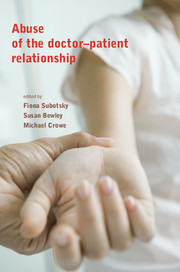Book contents
- Frontmatter
- Contents
- List of figures, tables and boxes
- List of contributors
- Foreword
- Introduction: mapping the territory
- 1 The ethical importance of boundaries to intimacy
- 2 The patient's perspective: impact and treatment
- 3 Teaching ethics and ethical behaviour to medical students
- 4 With the benefit of hindsight: lessons from history
- 5 The prevalence of boundary violations between mental health professionals and their clients
- 6 Psychiatry: responding to the Kerr/Haslam Inquiry
- 7 The general practitioner and abuse in primary care
- 8 Boundaries and boundary violations in psychotherapy
- 9 Sexual therapies: ethical guidelines, vulnerabilities and boundaries
- 10 Obstetrics and gynaecology: a special case?
- 11 Nurses as abusers: a career perspective
- 12 Medical management: governance and sexual boundary issues
- 13 Dealing with offending doctors: sanctions and remediation
- 14 Defending doctors: the protection society's experience
- 15 Regulation and its capacity to minimise abuse by professionals
- 16 The role of the General Medical Council
- Appendix 1 Extract from Vulnerable Patients, Safe Doctors
- Appendix 2 Codes of ethics of psychiatric associations in other countries
- Appendix 3 Guidance from the Council for Healthcare Regulatory Excellence
- Appendix 4 Examples of determinations by the General Medical Council's Fitness to Practise panels
- Appendix 5 Website resources and information
- Index
- Plate section
Foreword
Published online by Cambridge University Press: 02 January 2018
- Frontmatter
- Contents
- List of figures, tables and boxes
- List of contributors
- Foreword
- Introduction: mapping the territory
- 1 The ethical importance of boundaries to intimacy
- 2 The patient's perspective: impact and treatment
- 3 Teaching ethics and ethical behaviour to medical students
- 4 With the benefit of hindsight: lessons from history
- 5 The prevalence of boundary violations between mental health professionals and their clients
- 6 Psychiatry: responding to the Kerr/Haslam Inquiry
- 7 The general practitioner and abuse in primary care
- 8 Boundaries and boundary violations in psychotherapy
- 9 Sexual therapies: ethical guidelines, vulnerabilities and boundaries
- 10 Obstetrics and gynaecology: a special case?
- 11 Nurses as abusers: a career perspective
- 12 Medical management: governance and sexual boundary issues
- 13 Dealing with offending doctors: sanctions and remediation
- 14 Defending doctors: the protection society's experience
- 15 Regulation and its capacity to minimise abuse by professionals
- 16 The role of the General Medical Council
- Appendix 1 Extract from Vulnerable Patients, Safe Doctors
- Appendix 2 Codes of ethics of psychiatric associations in other countries
- Appendix 3 Guidance from the Council for Healthcare Regulatory Excellence
- Appendix 4 Examples of determinations by the General Medical Council's Fitness to Practise panels
- Appendix 5 Website resources and information
- Index
- Plate section
Summary
The doctor–patient relationship is at the core of treatment, whether psychological, pharmacological or surgical. There is considerable evidence that even when treatment involves no more than a prescription, the expectations and the nature of the therapeutic encounter dictate the response and acceptance of treatment. The doctor–patient interaction works at various levels and both sides respond to this, depending upon their experience, education, gender, ethnicity, age and other factors. The nature of the therapeutic interaction in psychiatry – in risk assessment and psychotherapy sessions especially – ensures that the psychiatrist is in a powerful position. This may lead to physical, sexual or emotional exploitation of the vulnerable individual, sometimes unintentionally but at other times deliberately.
Ethical issues related to such encounters are at the heart of this volume, which deals with the context, prevalence and sequelae of such events, and also considers prevention. Healthcare professionals have their own personality characteristics and life experiences, as do patients, which should not interfere with therapy but sometimes may. The editors are to be congratulated for providing a pragmatic and extremely helpful overview. They show that to improve upon the present situation there needs to be an increase in awareness and education, alongside better monitoring and regulation.
This book should be essential reading not only for trainees and psychiatrists, but also for other health professionals. The therapeutic encounter must be safe and beneficial for the patient. Both vulnerable patients and their carers must have full confidence in the probity and ethical values of a treating psychiatrist and the medical profession as a whole. It is up to the profession to set the standards and ensure that these are met. This book provides a welcome first step for raising standards. I hope it will be read widely.
- Type
- Chapter
- Information
- Abuse of the Doctor-Patient Relationship , pp. xi - xiiPublisher: Royal College of PsychiatristsPrint publication year: 2010

